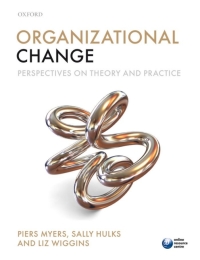In one of Pfi zers UK business units employing 1,000 people, 70 per cent were in sales
Question:
In one of Pfi zer’s UK business units employing 1,000 people, 70 per cent were in sales and worked from home. What communication strategy and tactics would work for them after the organization announced a global transformation programme in October 2006?
Between October 2006 and July 2007, staff experienced signifi cant uncertainty. High-level changes to the structure, headcount reductions, and the closure of one of the regional offi ces were announced in February. Previously, communication had been through regional leaders, but this was no longer possible as these roles were abolished. The new situation placed much greater communication responsibility on two senior directors: one in sales and one in customer marketing. They held regular formal consultation meetings with employee representatives, which were always followed within 24 hours by an audio broadcast to which all employees were invited to dial up and listen in. Each manager was encouraged to keep close to their homeworkers through the telephone and face-toface meetings.
In July 2007, to mark the birth of the new organizational structure, the two senior directors held twenty-one face-to-face meetings to symbolize ‘Day One’ in which people were introduced to their new managers. A conference that brought everyone together to hear about the vision for the new organization happened in September. In the run-up to the conference, ten volunteer salespeople were asked to take a camcorder to create a video diary recording their refl ections on the new organization and meetings with customers and colleagues. These were shown at the conference, interspersed with talking to the volunteers in daytime TV style. The video diaries were a complete change from the consultation process, which, of legal necessity, had been very formal and top-down. ‘As part of the transformation, we want people to take more accountability, be more innovative and take more risks. This communication process demonstrated those corporate aspirations’ said Edwards, the internal communications manager. The video diaries from employees were then put on the intranet.
With the new structure, a new leadership team of ten was created. To keep employees updated on the change programme, the ten leaders themselves began producing video summaries to explain progress with different workstream initiatives after their monthly meeting. This was published on the intranet, along with key messages, supporting documents, and a feedback tool.
The video diary summaries improved the ten leaders’ visibility and encouraged them to use a more non-corporate style of communication. In addition, members of the leadership team held road shows for groups of ten to twelve sales managers, with chairs, but no tables, and no formal agenda or presentations.
Questions 1. What types of communication strategy do you think were being used and why?
2. What do you imagine are the strengths and weakness of the media used in this case?
Step by Step Answer:

Organizational Change Perspectives On Theory And Practice
ISBN: 9780199573783,9780191512902
1st Edition
Authors: Piers Myers; Sally Hulks; Liz Wiggins





